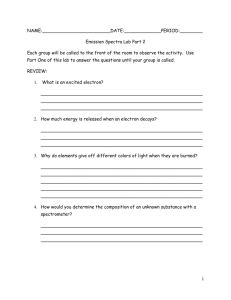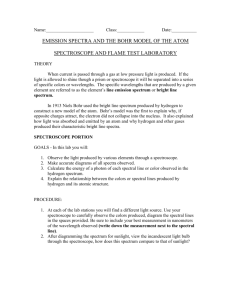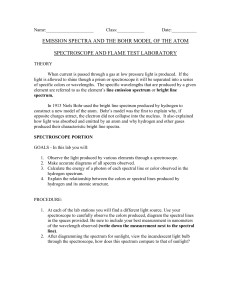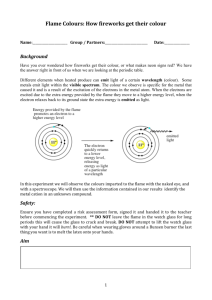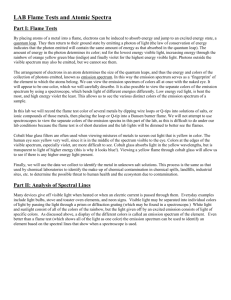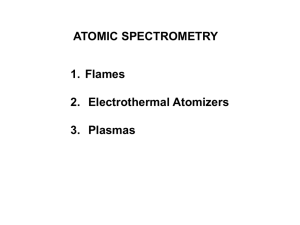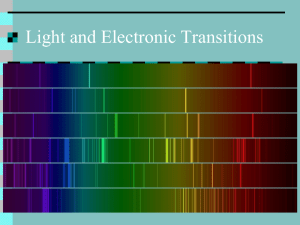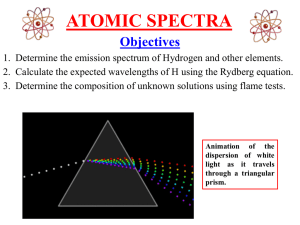Atomic Spectra
advertisement
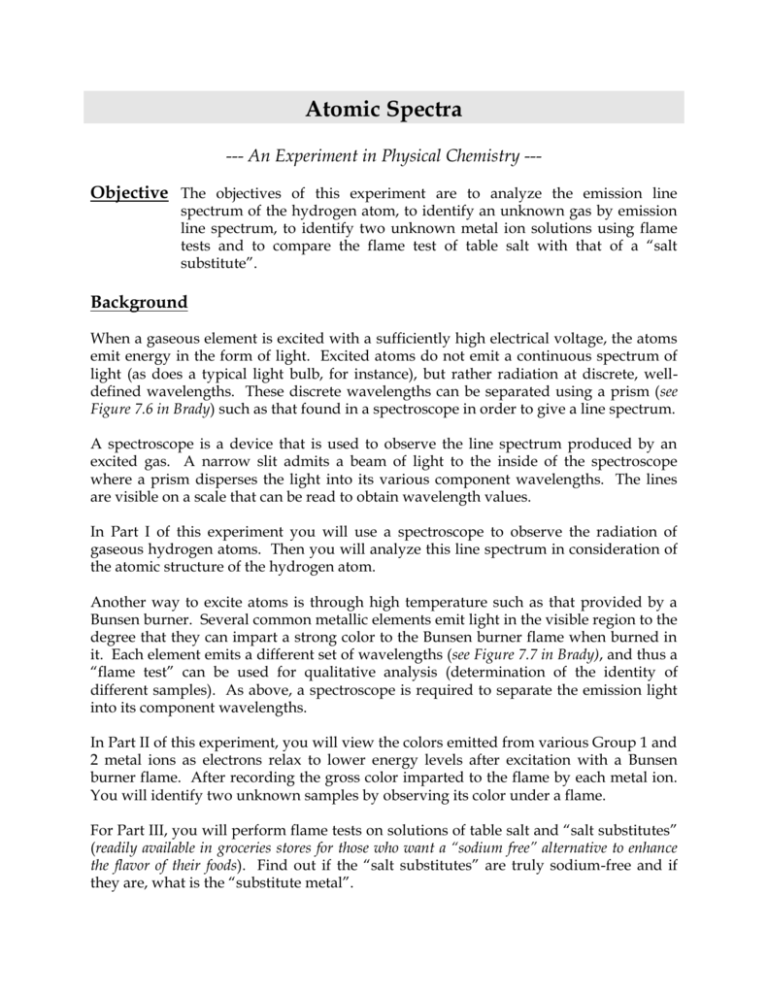
Atomic Spectra --- An Experiment in Physical Chemistry --Objective The objectives of this experiment are to analyze the emission line spectrum of the hydrogen atom, to identify an unknown gas by emission line spectrum, to identify two unknown metal ion solutions using flame tests and to compare the flame test of table salt with that of a “salt substitute”. Background When a gaseous element is excited with a sufficiently high electrical voltage, the atoms emit energy in the form of light. Excited atoms do not emit a continuous spectrum of light (as does a typical light bulb, for instance), but rather radiation at discrete, welldefined wavelengths. These discrete wavelengths can be separated using a prism (see Figure 7.6 in Brady) such as that found in a spectroscope in order to give a line spectrum. A spectroscope is a device that is used to observe the line spectrum produced by an excited gas. A narrow slit admits a beam of light to the inside of the spectroscope where a prism disperses the light into its various component wavelengths. The lines are visible on a scale that can be read to obtain wavelength values. In Part I of this experiment you will use a spectroscope to observe the radiation of gaseous hydrogen atoms. Then you will analyze this line spectrum in consideration of the atomic structure of the hydrogen atom. Another way to excite atoms is through high temperature such as that provided by a Bunsen burner. Several common metallic elements emit light in the visible region to the degree that they can impart a strong color to the Bunsen burner flame when burned in it. Each element emits a different set of wavelengths (see Figure 7.7 in Brady), and thus a “flame test” can be used for qualitative analysis (determination of the identity of different samples). As above, a spectroscope is required to separate the emission light into its component wavelengths. In Part II of this experiment, you will view the colors emitted from various Group 1 and 2 metal ions as electrons relax to lower energy levels after excitation with a Bunsen burner flame. After recording the gross color imparted to the flame by each metal ion. You will identify two unknown samples by observing its color under a flame. For Part III, you will perform flame tests on solutions of table salt and “salt substitutes” (readily available in groceries stores for those who want a “sodium free” alternative to enhance the flavor of their foods). Find out if the “salt substitutes” are truly sodium-free and if they are, what is the “substitute metal”. Apparatus Chemicals Spectroscope Hydrogen lamp Bunsen burner Cotton balls Reference chart of emission spectra Glassblower glasses LiCl, 0.1 M NaCl, 0.1 M KCl, 0.1 M CaCl2, 0.1 M SrCl2, 0.1 M BaCl2, 0.1 M Unknown metal ion solutions Table Salt & Salt Substitute Procedure Part I. Analysis of the emission spectrum of the hydrogen atom Note Each person should collect his/her own data for this part. You may later compare data with your partner. 1. With the hydrogen lamp turned on, look through the narrow end of the spectroscope as you point the slit on left side of the wide end towards the lamp. Towards the right side there should be an illuminated numbered scale and some vertical colored lines. This will take some trial and error in terms of the angle with which you hold the spectroscope as well as the ambient light in the room. Note The numbered scale goes from 4 to 7. The scale is in hundreds of nanometers (nm) so that 4 corresponds to 400 nm, 5 to 500 nm, etc. 2. If you see a continuous spectrum like in a rainbow, you have not focused the spectroscope correctly. Keep adjusting until you see the line spectrum. Below is part of what you might see. 4 blue line 5 6 7 green line 3. Sketch a diagram that represents what you see in the spectroscope. Note the color of each line. Try to record the wavelength to at least two significant figures, e.g., 420 nm or 425 nm. 4. Calculate the energy of an electron in the hydrogen atom when n = 6, n = 5, n = 4, n = 3, n = 2. You can use the formula provided below. Recall that the atomic number (Z) of hydrogen is 1 and the Ry constant = 2.18 x 10-18 J. En = - Ry ( Z2 / n2 ) Show your calculations and summarize then in a table. n=6 n=5 n=4 n=3 n=2 En , Joules 5. Prepare a table that lists all the electronic transitions in the hydrogen atom that emit light in the visible region of the spectrum. State each transition in the following form: n = ? n = ?. For each visible line find the difference in energy between the two relevant energy levels (Ehigh – Elow = E ). Use the energy released during the electron transition to calculate the frequency (), and wavelength () of the emitted photons ( Eatom = -Ephoton = h = h(c/)). In your lab notebook, summarize these values in a table like the one available in the course website. Calculate the % Error between the calculated and the observed wavelengths. Include all your calculations in your lab notebook. Analysis of the Emission Line Spectrum of the Hydrogen Atom Color Transition Calculated E, J Calculated Frequency, s-1 Calculated Wavelength (nm) Observed Wavelength (nm) Percent Error 6. Your instructor will assign you an unknown gas: A, B, C or D. Record your assigned unknown in your lab notebook. View the emission spectrum of the unknown gas using the spectroscope. Make notes of what you observe. Compare the spectra of the unknown gas to those available at the website provided below so that you can identify the unknown: http://www.colorado.edu/physics/2000/quantumzone/index.html The unknown gas is going to be either: Helium, Lithium, Beryllium, Boron, Nitrogen, Neon, or Argon. Part II. Identification of two unknown metal ion solutions using flame tests Caution Use the Bunsen burner carefully, and never leave it unattended while ignited. Handle hot glassware and metal with care. 1. Light a Bunsen burner to use as an excitation source. 2. For the chloride solution of each of the ions Li+, Na+, K+, Ca2+, Sr2+, and Ba2+, perform flame tests as shown by your lab instructor. Observe and record the gross color that each ion imparts to the flame while wearing the special glass blower glasses. Exception: since the special glasses block the sodium emissions, you will have to take off the glasses to look at the sodium flame. 3. Obtain two unknown solutions and record their numbers. Determine the metal ions present in the solutions based on the gross color that it imparts to the flame. It will be one of the six ions that you tested. Part III. Flame Tests of Table Salt and “Salt Substitutes” 1. Compare the flame color of table salt vs. salt substitutes, with and without the glasses. Is there a difference? Can you determine what metals are present in each of these? Record the name brand of the salt substitute(s) tested. 2. If available, perform flame tests on solutions made with “Sea Salt”. Do you detect any differences to table salt?
